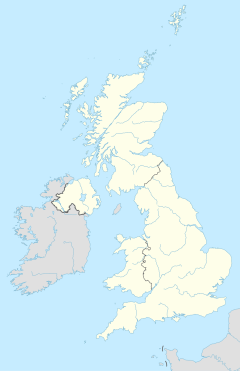Haddington
| |
|---|---|
| Town and administrative centre | |
 A view of Haddington showing Haddington Town House with its added spire | |
 Administrative Centre for East Lothian | |
| Population | 10,360 (2022)[1] |
| OS grid reference | NT511739 |
| • Edinburgh | 17 mi (27 km) |
| • London | 393 mi (632 km) |
| Council area | |
| Lieutenancy area | |
| Country | Scotland |
| Sovereign state | United Kingdom |
| Post town | HADDINGTON |
| Postcode district | EH41 |
| Dialling code | 01620 |
| Police | Scotland |
| Fire | Scottish |
| Ambulance | Scottish |
| UK Parliament | |
| Scottish Parliament | |
The Royal Burgh of Haddington (Scots: Haidintoun,[2] Scottish Gaelic: Baile Adainn) is a town in East Lothian, Scotland. It is the main administrative, cultural and geographical centre for East Lothian. It lies about 17 miles (27 kilometres) east of Edinburgh.[3] The name Haddington is Anglo-Saxon, dating from the sixth or seventh century AD[4] when the area was incorporated into the kingdom of Bernicia. The town, like the rest of the Lothian region, was ceded by King Edgar of England and became part of Scotland in the tenth century. Haddington received Burgh status, one of the earliest to do so, during the reign of David I (1124–1153),[5] giving it trading rights which encouraged its growth into a market town.
Today, Haddington is a small town with a population of about 10,000 people, but during the High Middle Ages it was the fourth-biggest town in Scotland (after Aberdeen, Roxburgh and Edinburgh). In the middle of the town is the Haddington Town House, completed in 1745 based on a plan by William Adam.[6] When first built, it contained markets on the ground floor, and an assembly hall on the first floor to which improvements were made in 1788, and a spire was added in 1831.[6] Nearby is the corn exchange (1854) and the county courthouse (1833). Other notable nearby sites include: the Jane Welsh Carlyle House; Mitchell's Close; and a building on the High Street that was the birthplace of the author and government reformer Samuel Smiles and is marked by a commemorative plaque. John Knox was probably born in Haddington and Knox Academy, the local high school, is named after him.
- ^ "Mid-2020 Population Estimates for Settlements and Localities in Scotland". National Records of Scotland. 31 March 2022. Retrieved 31 March 2022.
- ^ "Scotslanguage.com - Names in Scots - Places in Scotland". www.scotslanguage.com.
- ^ Barclay, George (1793). The statistical account of Scotland. Drawn up from the communications of the ministers of the different parishes (Vol 6 ed.). Edinburgh: W. Creech. p. 535. Retrieved 29 September 2018.
- ^ Book:- Jones, Charles (1997). The Edinburgh History of the Scots Language. Edinburgh University Press. p. 57. ISBN 0-7486-0754-4.
- ^ Book:- Gray, W. Forbes (1944). A Short History of Haddington. East Lothian Antiquarian and Field Naturalist’s Society. p. 1. ISBN 0-907590-54-3.
- ^ a b "Haddington Town House". Dictionary of Scottish Architects. Retrieved 9 July 2021.


